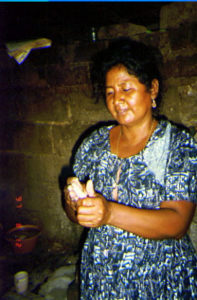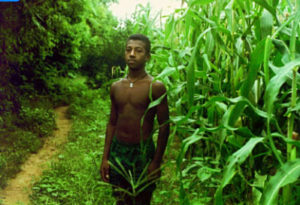The Costa Chica (“Short Coast” in Spanish) is one of two regions in Mexico with significant Black communities, the other being the state of Veracruz on the Gulf coast. The Costa Chica is a 200-mile-long coastal region beginning just southeast of Acapulco, Guerrero, and ending near the town of Puerto Angel, Oaxaca.
The shaded area in the map shows the location and extent of the Costa Chica.

There are no real tourist attractions in the parts of the Costa Chica where most Blacks live, although there are a few pleasant local beaches: Marquelia and Punta Maldonado in Guerrero. I should also mention the wildlife reserve in Chacahua, Oaxaca, located near the Black town of the same name.
While the Costa Chica is home to many Blacks, there are many indigenous groups, as well. I have spent very little time learning about these people, and can’t speak with very much confidence about them. What I do know is that there are two major indigenous ethnic groups in the region: the Amuzgos, the coastal Mixtecs and, to a lesser extent, Tlapanecos and Chatinos.

What is also clear to me is that there is very little social interaction between Blacks and indigenous people. Part of this is the issue of the language barrier, but I believe the issue is much more complex than that. There has been a long history of hostility between the two groups, and while today there is no open hostility, negative stereotypes abound on both parts. I would hope to explore these inter-ethnic relations further, and that would likely require my learning one of their languages. Wish me luck!

Most of the homes in the region were round mud huts, whose roots have been traced back to what is now Ghana and the Ivory Coast. Now, the norm is a one-room house with wall of adobe. Also, while some of the better houses are constructed with brick or cinderblock, others can be a rather makeshift structure of sticks, mud and cardboard.
The economic base of the Costa Chica, not unlike most of the rest of the country, is agricultural. These campesinos, or peasant farmers, concentrate most of their efforts in the cultivation of corn, almost exclusively in order to make tortillas for their own consumption. Other common crops are coconut, mango, sesame, and some watermelon.















my question is how did the blacks come to get to this region?
See https://www.mexconnect.com/articles/1167-did-you-know-blacks-outnumbered-spaniards-until-after-1810/ for more details, or chapter 10 of my Mexican Kaleidoscope” myths, mysteries and mystique.
I am actually taking a class on how the blacks came to all latin american regions via the slave trade right now at Georgia State for their MA program and this is the book we are currently using if you would like to look deeper into it!
Trans-afrohispanismos
Puentes culturales críticos entre África, Latinoamérica, y España
Dorothy Odartey-Wellington edition
Sara, Thanks for your informative comment and for the book recommendation, which I’m sure will interest many of our readers. Best wishes with your MA studies, Tony.
Trans Atlantic Slave Trade and some escaped Slave Plantations in America.
Read. Learn to read. But short answer black people where always there.
The unpopular truth is we have always been here in all of the Americas including the Carribean. The so called Afro Mexicans are the descendants of the Ancient Olmecs, not slaves from Africa.
Completely false!! The afrodescended people are from various west African nation/states who were captured and enslaved through the Slave Trade. DNA evidence has showed that! If your assertion had merit, then comparing the DNA of the Olmec people vs that of the current Afro sample would be an excellent strategy for proof of concept,
Exactly right
It was slavery of course. Many either were brought there or escaped slavery in the US.
Google is your friend. Here is an article from Lonely Planet that has some info on Afro-Mexicans: https://www.lonelyplanet.com/articles/brief-guide-to-afro-mexican-history-and-culture
I’m in Oaxaca City now and would love to visit the Costa Chica region to learn and cover some of it in my travel content and possibly connect with willing people in the area open to sharing their experiences as Afro-Mexicanos. With the many towns in that region, is there a particular town recommended to visit (in regards to access- ADO/bus and infastructure/hotels)? Or even an organization to connect with? Thanks for your time and for sharing your experience.
Apryl, Sorry, but we’re not in a position to respond adequately to your query. I suggest you ask it on one of the many Facebook groups dedicated to Mexico, such as the easy to join On The Road in Mexico – https://www.facebook.com/groups/ontheroadinmexico If you do visit the Costa Chica area, we’d love an update on the area. Safe travels.
All of the Afro Mexicans, Afro Americans, Afro Chileans, Afro Colombians, Afro Paraguayans, Afro Uraguayans, Afro Brazilians, etc. were NOT brought through the slave trade.
The only way to obtain the justice for these peoples is to showcase TRUTH. And the TRUTH is most of them are indigenous to the land. Do the research.
Just like many Black Americans were told they came from Africa, and recently we have been seeing that that is a far stretched lie, the Afro Mexicans are also told that they descend from Africa. This is not to say chattel slavery did not exist, it very well did. But the Spanish, French, British, etc. colonizers found it easier to use the population that was already in the Americas, rather than import them. The ones they did import found it extremely easy to assimilate with the indigenous peoples of the America because THEY LOOKED SIMILAR TO EACH OTHER.
Now, what I typed is either TRUE or it is FALSE. Do the research.
I belong to the Afro-descendant community of José María Morelos in the Costa Chica of Oaxaca. Yet today the community identifies as “negros” in a long-denied claim to the third root in Mexico. It’s true that these towns were made up of slaves who escaped from their masters, the so-called “cimarrones” who in turn mixed with the indigenous communities of the region. There are vestiges of this as well as a tradition that is typical of AFRICA, the phenotype is not the only thing that identifies us as Afro-descendants and there is a whole investigation. Who is misinformed is you.
All Afrodescendants in the Americas were initially brought by European slave ships. Some Africans escape early or before the majority of ships brought more Africans and they formed their own communities for survival. The more isolated, the more mountainous, the least accessible landscapes, etc provided the ability to live in harmony most of the time until they forced “treaties”to be able to come and go as they pleased with their European “colonizers”. See Palmares (Brazil), Marrons (Jamaica), Palenques (Colombia), Berbice Salve Uprising-1763 (Guyana).
The Olmec heads are a “false flag” of African presence but again the Eurocentric descruptive of the heads as being of “that kind”, whatever that MAY infer can be projected to be what we know today as a “black African shape” keeping in mind that the indigenous of the day in the Americas were of that phenotype. What we see today identified as being indigenous are actually mestizo or mulato phenotype prancing around as being as indigenous since that is indeed part of their heritage per local geographical and cultural leaning of this day.
WRONG! Not all Afro-descendants in the Americas were initially brought by European slave ships… Lol, your knowledge is a “False Flag” Not all Blacks were slaves or brought as slaves.. You got your knowledge from a book or reading that was sourced by a White man so of course it’s going to be biased. Mexico itself has a dedicated special monument honoring the Olmec people.
Hello Everyone, My name is Dailton and my father is from San marcos guerrero La costa chica. My dad is different from a lot of mexicans he is more dark and people confuse him for being african american and looks like one but only speaks spanish. My dad was in The U.S for 30+ yearsuntil he recently had to do 6 years in prison for something he did not do . About 3 months ago he was set free and deported back to his homeland. The interesting part is every time he calls i get to talk to my grandma. One day i decided to ask her a question about her mother and grandmother and so on decades back. She started telling me how her dad on great grandad escaped from one of the boats that landed in san marcos during slave trade. The more she tells me about it the more goosebumps and interesting it gets.
Dailton, Thanks for your very interesting comments about your personal family history. If you are ever interested in writing a short article (600-1000 words) about your family’s story, we would love to consider it for publication. Such personal stories are always welcome and always appreciated by our readership. Saludos, TB.
What’s missing in history to compliment your family history is that the slave trade happened in reverse and that they may have been on a slave ship coming from North America going to the Carribean. Many Indigenous peoples (including my ancestors) were enslaved in North America and shipped out.
It make a lot of logical sense if you think about it. Just consider how close Louisiana is to Mexico, they share the Gulf of Mexico.